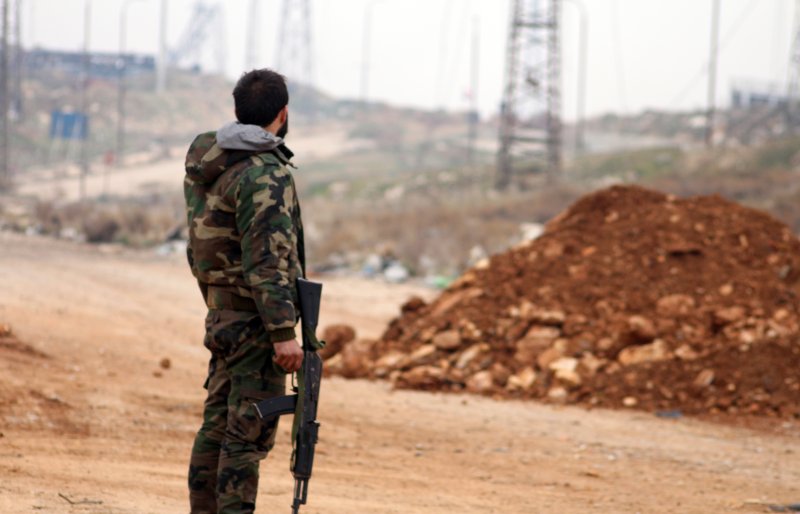A Syrian solider looks at al-Ramousseh crossing, where fighters of the rebels were scheduled to leave in the eastern neighborhoods of Aleppo, Syria, on December 16. Photo by European Pressphoto Agency
BEIRUT, Lebanon -- A hallmark of the Syrian regime's policy to recover territory held by rebel groups is the surrender-or-starve tactic, a brutal binary choice for the defenders of opposition-held towns and neighborhoods across western Syria that has paid dividends for President Bashar al-Assad and his multinational allies.
Access points in and out of the targeted area are sealed by regime forces and the population is subjected to intense aerial and artillery bombardment. As food, medicine, water and fuel supplies dwindle, pressure mounts on civilians and fighters to surrender.
The recent six-month siege and relentless bombardment of eastern Aleppo, with a population of 200,000 people, was the acme of this uncompromising tactic.
These deals — known in regime-speak as "reconciliation agreements" to disguise a tactic that many consider to be a war crime — are more commonplace than is generally appreciated.
The Russian Defense Ministry's Centre for Reconciliation of Opposing Sides in the Syrian Arab Republic said that, as of mid-December, the number of "reconciliation agreements" secured across Syria stood at 1,057, with another 94 cease-fire deals.
As the world looked on while Aleppo, once Syria's economic hub, was battered into rubble, the Assad regime was pursuing the same policy elsewhere, notably on Damascus' periphery.
In October, Assad's forces launched an offensive against rebel-held Khan al-Sheikh, a town in Western Ghouta that sits on the key highway linking Damascus to Daraa in the south. By the end of the month, the town was surrounded and had been hammered by dozens of barrel-bomb assaults and rocket barrages.
On Nov. 19, an agreement was reached in which the population would be allowed to go to Idlib province in the north, a rebel stronghold. Rebels also could leave after surrendering their heavy weapons.
About 3,000 people, half of them militants, left Khan al-Sheikh in late November. Rebels in four nearby villages also cut deals with the regime and departed for Idlib, leaving the area firmly in Assad's grip for the first time since the uprising against his rule began in March 2011.
In mid-November, before the eastern Aleppo evacuation deal had been brokered, dozens of Hezbollah fighters were mobilized in the Sarafand area of southern Lebanon and deployed to Syria to lead an assault to break the rebel siege of Kefraya and Fouaa, two Shia villages in Idlib, sources close to the party said.
Kefraya and Fouaa are already part of a cease-fire deal with Zabadani and Madaya, rebel towns near the Lebanese border that are besieged by Hezbollah. If the assault to relieve Kefraya and Fouaa had been successful, Hezbollah intended to storm Zabadani and Madaya, the sources said.
Zabadani lies close to Shia-populated villages and sensitive Hezbollah-controlled locations on the Lebanese side of the border. That makes its return to Syrian state control imperative for the Iranian-backed movement.
However, the planned assault was apparently overtaken by events in Aleppo when a deal was struck by Turkey and Russia to allow the population in the eastern sector to leave for Idlib.
Iran and Hezbollah objected, demanding that Zabadani, Madaya, Fouaa and Kefraya be included in the deal.
It is unclear whether the expanded deal will be implemented but the surrender-or-starve policy and subsequent evacuations of besieged populations raises the question what will happen to the towns, villages and neighborhoods in the future.
Will their people be allowed to return if the war ends?
A pointer may lie in what happened in Qusayr, a mainly Sunni town in Homs province near the Lebanese border. In June 2013, Hezbollah seized the town. The Sunnis and rebel fighters fled.
Qusayr is now an important Hezbollah military base and staging point for deployments deeper into Syria. Recruits use the ruins to train for urban warfare.
Several villages west of the town have been populated by Lebanese Shias for decades. To all intents and purposes, Qusayr and nearby villages have effectively become an extension of Lebanon's northern Bekaa valley, Hezbollah's heartland.
As things stand, it is doubtful whether the Sunni residents will ever fully return to Qusayr. The same could hold for Zabadani and Madaya if a deal is reached that allows for their evacuation along the well-trodden path to Idlib, which is fast becoming a refuge for Sunnis from across Syria.
Even some Damascus neighborhoods have seen effective population transfers, such as Daraya, where 10,000 people left in August, and Moadamiyeh ash-Sham, both of which surrendered after four-year sieges.
The Syrian opposition has long accused the Damascus regime of seeking to reduce the Sunni presence in western Syria to strengthen Assad's grip on the routes linking Damascus to Latakia on the northern coast.
Nevertheless, Hezbollah leader Hassan Nasrallah on Dec. 23 said the Assad regime does not seek to impose "demographic changes" in Syria.
"Armed groups were behind the demographic changes that happened," he claimed, adding that people driven out of Aleppo and Daraya would eventually return to their homes.
Whether those displaced Sunnis are indeed allowed to return to their homes remains to be seen — as does whether they would wish to if Assad remained in power.
This article originally appeared at The Arab Weekly.















